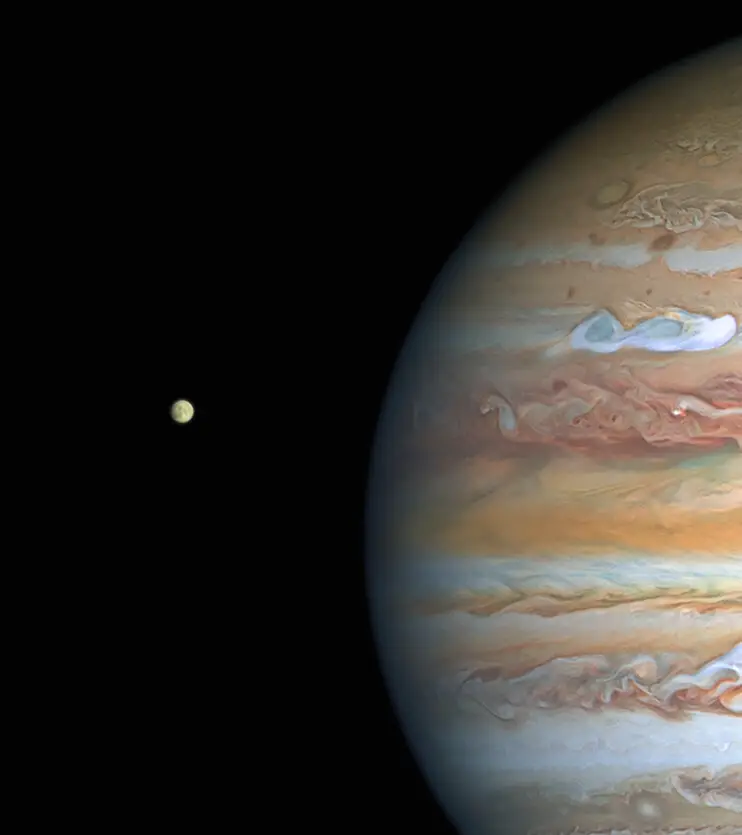Europa is often called Earth’s sister planet, and it has striking similarities to our own home in many ways. One of the most intriguing aspects of Europa, though, lies beneath its frozen surface — scientists suspect that the ocean that covers Europa may contain more than twice as much water as all of Earth’s oceans combined! If any life does exist on Europa, it may be hidden beneath the icy crust of this outermost Galilean moon of Jupiter, but if we dig deep enough into Europa’s ocean, we might just find it.
What is Europa
A moon of Jupiter and one of its four Galilean satellites. With a diameter of 3,122 km (1,939 mi), it is slightly smaller than Earth’s Moon. Europa was discovered in 1610 by Galileo Galilei and was named after a figure from Greek mythology. It is covered with an ice layer that averages about 10 km (6 mi) thick; below which lies an ocean about 100 km (60 miles) deep. The surface has numerous ridges and grooves presumably caused by plate tectonics. The present-day surface is geologically inactive but may have been active in the past. The apparent youth and smoothness of Europa’s surface have led to the hypothesis that a water ocean exists beneath it, which could conceivably harbor extraterrestrial life. For example, NASA has stated: Europa might be able to support life as we know it. In addition, recent evidence suggests that Europa might possess plumes of water vapor erupting from its south polar region. Sending probes to explore Europa: Launching a probe into space is expensive, but sending one all the way out to Jupiter and beyond can cost tens of billions of dollars—and getting approval for such missions takes years.
How We May Get to Europa
While there’s a lot we don’t know about Jupiter’s icy moon, Europa—like whether it has water and how much—scientists are discovering more and more reasons to think it could potentially host life. And here’s how they may get us there. In 2016, NASA announced plans for its next big mission: Europa Clipper. This spacecraft will launch in 2022 with a planned arrival in 2027 (that is, if everything goes according to plan). The probe will be equipped with nine instruments that will perform 45 flybys of Europa over two years, making observations as it zips by. As soon as 2024, NASA wants to follow up with an orbiter that would hover around Europa for three years or so before eventually crashing into its surface. If all goes well, these missions will provide us with some of our best data yet on what lies beneath Europa’s icy crust. But what if scientists find something compelling enough to warrant sending down a lander? That’ll require a separate mission. But researchers have already begun studying possible designs for such a lander, which would likely touch down near one of Europa’s many geysers and drill through at least 10 feet of ice to sample whatever liquid is spewing out from below.
What We Might Find
Research led by Kevin Hand, a planetary scientist at NASA’s Jet Propulsion Laboratory in Pasadena, California, suggests that life may exist in Jupiter’s ice-encrusted ocean. Hand and his colleagues are modeling a type of microbial organism called an extremophile — organisms that live and thrive in conditions previously thought to be uninhabitable — which survive by feeding off hydrogen gas in Earth’s oceans. The researchers think these organisms could also survive in similar environments elsewhere in our solar system, including beneath Europa’s icy surface. If correct, says Hand, this research suggests that astrobiologists might one day sample plumes of biological material ejected from the seafloor of Europa. This finding is just one piece of evidence pointing toward potential life on Europa; it does not mean we have found extraterrestrial microbes there or anywhere else. But it does add weight to other lines of reasoning scientists use to make their case for habitability. For example, scientists recently discovered water vapor erupting from Europa’s south polar region (one potential source being salty seawater erupting out through cracks in Europa’s frozen crust). These findings suggest that hydrothermal activity — chemical reactions between seawater and rock at high temperatures — occurs on Europa. Such activity would support diverse ecosystems below its surface, as it does here on Earth around deep-sea hydrothermal vents.
What Would Happen If There Was Life On Europa
The key to finding out what would happen if there was life on Europa is understanding what’s already happening on Europa. The ocean beneath its icy crust is thought to have twice as much water as Earth, and it’s being squeezed and heated by Jupiter’s enormous gravitational pull. If there are bacteria in that water, they’re under tremendous pressure—they may even be squished between huge plates of ice or melted into a deep soup at high temperatures. Could these creatures survive under these conditions? What would they look like? How might we find them? This week, scientists from NASA and SETI announced they were working together to answer those questions. They will use data from NASA’s upcoming Europa Clipper mission (scheduled for launch sometime in 2022) to determine whether an instrument called a mass spectrometer can detect organics on Europa—and if so, whether those organics could come from living organisms. In other words: they want to know if Europa has life. If there is life on Europa, how might it affect our search for alien intelligence? Organisms that live in extreme environments here on Earth often seem bizarre; think tardigrades, which can live almost anywhere including outer space. But just because something looks weird doesn’t mean it isn’t intelligent; indeed, some researchers believe intelligent extraterrestrial beings may resemble nothing more than slime mold or pond scum.
![]()
